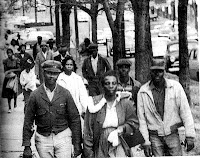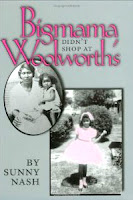 |
Rosa Parks after Montgomery
Bus Boycott 1956 |
On December 1, 1955, a beautiful, smart, high-school educated, hard-working, 42-year-old seamstress, named Rosa Parks, boarded a bus after work. Like every weekday, she sat down on a seat designated 'black seating.' Stop to stop, the bus filled, leaving no vacancies in the white section. The bus driver, familiar with this situation, ordered Rosa Parks to move from her seat to allow more seating for white passengers.
Rosa Louise McCauley, born in 1913 and raised on her grandparents' farm in Alabama, was accustomed to inferior social treatment since she was a child, long before the start of the modern Civil Rights Movement began. In fact, Rosa Parks went on to become known as The Mother of the Civil Rights Movement.
In order to get an education, Rosa Parks walked to school because the same Jim Crow laws that prevented her from attending white schools in Alabama, also prevented her from riding the school bus when she was a young student. The school buses were not permitted to transport black students in the Jim Crow South. Below is a video sketch of the education of Rosa Parks, an excerpt from a YouTube Biography Channel program.
Jim Crow laws were in effect from 1876 to 1965. For more videos on race relations in America, Subscribe to my YouTube Channel, iksunny.
Rosa Parks eventually went back and finished high school after she married Raymond Parks, who also encouraged her to join him in working with the Montgomery National Association for the Advancement of Colored People (NAACP).
 |
| Sign: No Spanish or Mexican |
Rosa Parks wanted more opportunity. A person of color who had been denied decent treatment by society all of her life, Parks had finally had enough and refused to move when the bus driver ordered her to another seat. I can only imagine what must have been going through the mind of a woman who was fed up with it. I recognized the fed-up expressions on the faces of my mother, grandmother, father and others I knew when I had seen them in similar situations.
Again, the bus driver ordered Rosa Parks to move to another seat in his attempt to enforce a Jim Crow law that mandated racial segregation of all public and private facilities and separate but equal facilities for customers, clients, students, patrons, patients and passengers who were black or people of color.
 |
Segregated Alabama Bus
Source: Birmingham Public Library
Via: National Public Radio |
Jim Crow laws required blacks to give up seats to whites, as needed, determined by bus drivers. If whites were standing because their section of the bus was filled, the driver corrected the situation by ordering black riders to move from their seats to allow whites to sit instead. When Rosa Parks would not move from her seat, the bus driver haled a policeman to assist him in the matter.
I was six when the Montgomery Bus Boycott began. I knew about it because the Nash family took newspapers from all over the country and they explained to me what was going on. "It's a way of life that is ending," my mother said. "Nothing personal, just the end of a way of life. Are you ready?" I had a vague notion of what this meant but not really.
My family tried to protect me from the harshest of it all. There were places we didn't go. And that, I learned later, was to avoid the shame of it all. My mother only took me to segregated places that were absolutely necessary to my life--the doctor, bus station, movies, school and other public facilities where my presence was needed. We didn't eat out very often because restaurants required us to enter through a rear door, sit in an inferior location or walk up to an outdoor window to order and receive food. My cousin, Joyce, reminded me the other day that at the bus station in her home town required African Americans to eat their orders in the baggage room at discarded desks retrieved from a local school.
In the excerpt below from “Movies—Not Just Black-and-White,” one of the essays in my book, Bigmama Didn’t Shop At Woolworth’s, I write about the first time my mother took me to lunch and the movies. It was about to rain that Saturday afternoon but my young mother agreed to take her little daughter to the movies anyway:
Without reply, my mother dug into her tiny cloth coin purse and paid. Time passed as slowly as it could before her change and our food arrived. “Y’all can’t eat in here,” the cook said. Without a word, my mother grabbed my hand and dragged me to the back door. As we stood outside and ate in silence, I thought I saw a tear sparkle on my mother’s cheek as the day’s last sunlight stroked her face. With a few drops of rain falling on us, we took the short walk to the Palace Theater and stood at the ticket window outside the main lobby. The aroma of buttered popcorn floated through the little round hole in the glass where the ticket woman worked. To avoid getting wet in the shower, the moviegoers dashed through a glass front door into a dry, comfortable lobby filled with tiny white lights, velvet draperies, and red carpet. By the time my mother and I got our tickets, big drops of rain were splashing down on our heads. With her hair heavy with water, sliding into her face, my mother dug into her tiny cloth coin purse and paid. The little blue door on the outside of the theater slammed us inside the darkest place I’d ever been—like a coffin, I thought, holding my mother’s hand.
My mother, Littie Nash, wrestled with Jim Crow racism during the 1950s and 1960s, while giving me the life of a little princess with imagination and without the luxury of having a lot of money...Littie, the ultimate stage mother, did not waste compliments on me or anyone else. She reserved accolades to celebrate real accomplishments, not just because I dragged myself out of bed before noon on Saturday or because I made an 'A' on my report card. "Some things you have to do," she said. "And those things pass, not without notice, but without an all-day hullabaloo."
To support my efforts, my mother sponsored piano, ballet, tennis and swimming lessons, dance performances, recitals, literary and classical music club memberships, summer camps, school trips and science fair exhibits, still managing to squeeze out of our tight budget money for the dentist to install braces on my teeth. It took a great deal of courage to live with dignity and raise me to have aspirations. About my upbringing, Littie got it right, although I took detours of my own along the way. Read more at: Great Mothering in Jim Crow's World
AS EARLY AS 1943, Rosa Parks refused to board the bus using a rear entry, the door for black bus riders. Parks and her mother had always refused to enter the bus through the rear door, while other black riders bad to use the rear door. Rosa Parks had challenged Jim Crow bus policy in Montgomery twelve years before she boarded the bus on December 1, 1955, and started the Montgomery Bus Boycott. Nine months before the boycott, 15-year-old Claudette Colvin was dragged off a Montgomery bus by police, handcuffed and jailed on March 2, 1955. Her case, got little notice and no support. Review and purchase Claudette Colvin at links on left.
 |
| Rosa Parks |
On December 1, 1955, ordered by the bus driver to move, Rosa Parks refused. Did she make the decision alone? In her words, she says, we waited so long to make this protest, indicating the protest was decided, not by herself, but in concert with others. Why was Rosa Parks chosen to spark the boycott? Was it because she had a history of protest? Was it because she worked with the NAACP? Was it because she was part of a larger plan?
"The only thing that bothered me," Parks said. "Was that we waited so long to make this protest."
“People always say that I didn't give up my seat because I was tired,” Rosa Parks wrote in her autobiography, “but that isn't true. I was not tired physically, or no more tired than I usually was at the end of a working day. I was not old, although some people have an image of me as being old then. I was forty-two. No, the only tired I was, was tired of giving in.”
 |
A. Philip Randolph
& First Lady Eleanor Roosevelt,
Who, Like Randolph,
Supported Civil Rights
in the Armed Services,
& Pilot Training Programs
At Tuskegee Institute |
Rosa Parks was arrested, fingerprinted and paid a fine of fourteen dollars for refusing to follow bus driver’s orders, but was not jailed. Parks called Rev. E.B. Nixon, president of the Montgomery NAACP, a group with which Parks had worked diligently for some time as youth leader. Nixon called the Washington D.C. NAACP, a group that decided "to move on it today." Read below to see that there was more to Rosa Parks's interest in the Civil Rights Movement than integrating buses.
Rev. A. Philip Randolph and Dr. Martin Luther King, Jr., were brought into the Montgomery Bus Boycott quickly to organize efforts.
Asa Philip Randolph, born in 1889 in Florida, studied in New York and formed the Brotherhood of Sleeping Car Porters in 1925; helped form the Fair Employment Practices Committee; and threatened to organize a protest in Washington against discrimination in the armed forces and defense industries in the 1930s and 40s. In 1955, he joined the AFL-CIO executive council and was vice president in 1957. Randolph helped to organize the 1963 March on Washington. He died in 1979.
Dr. Martin Luther King, Jr., was in his mid-twenties at the time of the boycott, and had been the pastor at Dexter St. Baptist Church in Montgomery for only a short time when he became the official leader of the Montgomery Bus Boycott, which led him to later become the leading figure in the 1960s Civil Rights Movement in the United States.
 |
Rosa Parks
Booking Photo
|
 |
Martin Luther King
|
On December 5, 1955, the Montgomery Bus Boycott officially began. Signs and fliers announced to those who did not agree with policy that they should not ride. Rosa Parks, Martin Luther King, Jr., and 91 others were prosecuted for starting the bus boycott.
Because two-thirds of the bus riders in Montgomery were black, the NAACP was well aware that this bus boycott would strike a serious blow to the financial condition of the bus system. The black population of Montgomery at the time was about 40,000. If the entire black population participated in the boycott along with whites who were supporting the boycott or those trying to avoid trouble, then the total participation could have exceeded 50,000, which was the estimate of the Montgomery Improvement Association (MIA). More on the MIA later.
 |
Montgomery Bus Boycott
Rain, Shine, Sleet & Snow
People Walked to Work,
Church and Everywhere |
In the dead of winter, most people around the nation were beginning to prepare for their annual shopping traditions, gift selecting and wrapping rituals, rich and savory family holiday dinners. While Christmas and all the celebrations were in the air, Montgomery bus riders tackled the weather in coats, hats, scarves and rain gear. But they stayed off the buses. Montgomery citizens lost jobs, either because they couldn’t get to work or they were fired out of hostility. Non-the-less, they simply refused old racist treatment. Following Rosa Parks and her courageous action, people used carpools and walked to work and every other place they had previously ridden buses.
 |
Montgomery Bus Boycott
Protesters Walking to Work & School |
Many white citizens were against the Montgomery Bus Boycott. It threatened racial status quo. What is slow to be revealed is that some white sympathizers tried to participate in the boycott by providing black workers rides to work. Some say this seemingly generous action was selfish on the part of whites who wanted the work done.
Observers of the historical event say the action of mostly white housewives may have started out as a way to get their maids to work, but ended up with them providing rides to other black workers, as well. I have not been able to locate any photographs of whites driving black workers during the boycott. Perhaps pictures of whites driving blacks are scarce because some whites in the Jim Crow South were careful not to be identified with the growing Civil Rights Movement, which would have made them vulnerable in their own racist communities.
Whites, along with blacks who were providing rides during the Montgomery Bus Boycott, were refused taxi permits to prevent them from carrying passengers in their private vehicles. When these white drivers provided rides anyway, they were harassed by Ku Klux Klan members who were often law enforcement and just as often their neighbors. Identified as bus boycott affiliates, black and white drivers reacted nonviolently. The Klan, however, turned violent, bombing the homes of Martin Luther King, Jr. and E.B. Nixon.
 |
Martin Luther King
Conducts MIA Meeting
Montgomery Bus Boycott |
MIA was organized specifically to address the needs of the bus boycott. This predominately black community group was made up of blacks and whites with a basic goal of improving race relations in Montgomery, Alabama. Martin Luther King, Jr., (right) conducts an MIA meeting in 1955. Rosa Parks is seated in the front row.
Through two consecutive Christmas Holidays, with me and the world watching, this non-rider policy in Alabama continued through rain, shine, sleet and snow and over again for more than a year, 381 days. On November 13, 1956, the Montgomery Bus Boycott ended when the United States Supreme Court decided that segregation laws were unconstitutional.
 |
Black Montgomery Bus Boycotters Boarding Bus
Through Front Entry after Supreme Court Decision
Rosa Parks Leading the Way |
Martin Luther King, Jr., wrote in his book, Stride Toward Freedom, "with a mixture of anxiety and hope, I read these words: 'The United States Supreme Court today affirmed a decision of a special three-judge U.S. District Court in declaring Alabama's state and local laws requiring segregation on buses unconstitutional. The Supreme Court acted without listening to any argument; it simply said 'the motion to affirm is granted and the Judgment is affirmed. At this moment my heart began to throb with an inexpressible joy. The darkest hour of our struggle had indeed proved to be the first hour of victory."
After her husband Raymond died, Rosa Parks co-founded the Rosa and Raymond Institute for Self Development, in February 1987 with Ms. Elaine Eason Steele, in honor of Raymond Parks (1903-1977), "the living legacy of two individuals who committed their lives to civil and human rights."
Rosa Parks is a hero, we all agree. Without her bravery and commitment, race relations in America would not have progressed at the speed it did. Parks, however, had a great deal of assistance in changing the the Jim Crow South. We have to remember in our quest for education on the civil rights era that there were churches, organizations and lots of people involved. Many individuals, who began with one sentiment, ended up with a totally different view of race.
What I now know that I did not know as a child is that many white people also felt burdened by that way of life, some of whom grew up a few blocks from me and attended separate schools but, later, became my closest friends. They were children back then, just like me, inheritors of the tradition. These were the same people who joined the marches, broke the old hiring rules and changed their minds after generations of careful conditioning by family and society.
Sunny Nash Articles Related to this Post
Other Related Articles by Sunny Nash
Rosa Parks and the Montgomery Bus Boycott, led by Dr. Martin Luther King, affected race relations in America and early Hollywood, in that, studios had to change with the new racial climate that had relegated black actors to servants' roles and mirrored pre-civil rights America.
In The Rosa Parks Story Angela Bassett becomes Rosa Parks in a portrayal of the legendary civil rights heroine that seems more real than performance. The article covers aspects of Rosa Parks' life and the Montgomery Bus Boycott with photographs and videos.
Woolworth's sit-ins by black and white college students in Greensboro NC between February and July 1960 integrated lunch counters cross the nation.
Race relations in America and Southern California were changed by 12 African American women who made a difference in Long Beach, featured in historical profiles, BREAKING THROUGH Lighting the Way.























